Assessment of AMSR2 Ice Extent and Ice Edge in the Arctic Using IMS
Abstract
1. Introduction
2. Data and Methods
2.1. Data
2.2. Method
3. Results
3.1. Ice Cover
3.2. Ice Edge
4. Discussion and Conclusions
Author Contributions
Funding
Acknowledgments
Conflicts of Interest
References
- Ackerman, S.; Strabala, K.; Menzel, W.; Frey, R.; Moeller, C.; Gumley, L. Discriminating clear sky from clouds with modis. J. Geophys. Res. Atmos. 1998, 103, 32141–32157. [Google Scholar] [CrossRef]
- Minnis, P.; Sun-Mack, S.; Young, D.F.; Heck, P.W.; Garber, D.P.; Chen, Y.; Spangenberg, D.A.; Arduini, R.F.; Trepte, Q.Z.; Smith, W.L. CERES Edition-2 cloud property retrievals using TRMM VIRS and Terra and Aqua MODIS data—Part I: Algorithms. IEEE Trans. Geosci. Remote Sens. 2011, 49, 4374–4400. [Google Scholar] [CrossRef]
- Box, J.E.; Colgan, W.T.; Christensen, T.R.; Schmidt, N.M.; Lund, M.; Parmentier, F.-J.W.; Brown, R.; Bhatt, U.S.; Euskirchen, E.S.; Romanovsky, V.E. Key indicators of arctic climate change: 1971–2017. Environ. Res. Lett. 2019, 14, 045010. [Google Scholar] [CrossRef]
- Meier, W.N.; Kern, S.; Holland, M.; Tamura, T. Changes in Arctic sea ice extent, concentration and thickness. In Snow, Water, Ice, and Permafrost in the Arctic (SWIPA) 2017; Arctic Monitoring and Assessment Programme (AMAP): Oslo, Norway, 2017; pp. 105–111. [Google Scholar]
- Maslanik, J.; Stroeve, J.; Fowler, C.; Emery, W. Distribution and trends in arctic sea ice age through spring 2011. Geophys. Res. Lett. 2011, 38. [Google Scholar] [CrossRef]
- Serreze, M.C.; Meier, W.N. The arctic’s sea ice cover: Trends, variability, predictability, and comparisons to the Antarctic. Ann. N. Y. Acad. Sci. 2019, 1436, 36–53. [Google Scholar] [CrossRef] [PubMed]
- Stroeve, J.C.; Jenouvrier, S.; Campbell, G.G.; Barbraud, C.; Delord, K. Mapping and assessing variability in the Antarctic marginal ice zone, pack ice and coastal polynyas in two sea ice algorithms with implications on breeding success of snow petrels. Cryosphere 2016, 10, 1823–1843. [Google Scholar] [CrossRef]
- Stroeve, J.C.; Kattsov, V.; Barrett, A.; Serreze, M.; Pavlova, T.; Holland, M.; Meier, W.N. Trends in arctic sea ice extent from CMIP5, CMIP3 and observations. Geophys. Res. Lett. 2012, 39. [Google Scholar] [CrossRef]
- Overland, J.E.; Wang, M. When will the summer arctic be nearly sea ice free? Geophys. Res. Lett. 2013, 40, 2097–2101. [Google Scholar] [CrossRef]
- Strong, C.; Foster, D.; Cherkaev, E.; Eisenman, I.; Golden, K.M. On the definition of marginal ice zone width. J. Atmos. Ocean. Technol. 2017, 34, 1565–1584. [Google Scholar] [CrossRef]
- Ivanova, N.; Pedersen, L.T.; Tonboe, R.T.; Kern, S.; Heygster, G.; Lavergne, T.; Sørensen, A.; Saldo, R.; Dybkjær, G.; Brucker, L. Inter-comparison and evaluation of sea ice algorithms: Towards further identification of challenges and optimal approach using passive microwave observations. Cryosphere 2015, 9, 1797–1817. [Google Scholar] [CrossRef]
- Peng, G.; Meier, W.N.; Scott, D.J.; Savoie, M.H. A long-term and reproducible passive microwave sea ice concentration data record for climate studies and monitoring. Earth Syst. Sci. Data 2013, 5, 311–318. [Google Scholar] [CrossRef]
- Meier, W.N.; Fetterer, F.; Savoie, M.; Mallory, S.; Duerr, R.; Stroeve, J. NOAA/NSIDC Climate Data Record of Passive Microwave Sea Ice Concentration, Version 3; NSIDC: National Snow and Ice Data Center: Boulder, CO, USA, 2017. [Google Scholar]
- Ivanova, N.; Johannessen, O.M.; Pedersen, L.T.; Tonboe, R.T. Retrieval of arctic sea ice parameters by satellite passive microwave sensors: A comparison of eleven sea ice concentration algorithms. Geosci. Remote Sens. IEEE Trans. 2014, 52, 7233–7246. [Google Scholar] [CrossRef]
- Cavalieri, D.J.; Parkinson, C.L.; Gloersen, P.; Comiso, J.C.; Zwally, H.J. Deriving long-term time series of sea ice cover from satellite passive-microwave multisensor data sets. J. Geophys. Res. Ocean. 1999, 104, 15803–15814. [Google Scholar] [CrossRef]
- Markus, T.; Cavalieri, D.J. An enhancement of the NASA team sea ice algorithm. IEEE Trans. Geosci. Remote Sens. 2000, 38, 1387–1398. [Google Scholar] [CrossRef]
- Comiso, J.C.; Cavalieri, D.J.; Parkinson, C.L.; Gloersen, P. Passive microwave algorithms for sea ice concentration: A comparison of two techniques. Remote Sens. Environ. 1997, 60, 357–384. [Google Scholar] [CrossRef]
- Kaleschke, L.; Lüpkes, C.; Vihma, T.; Haarpaintner, J.; Bochert, A.; Hartmann, J.; Heygster, G. SSM/I sea ice remote sensing for mesoscale ocean-atmosphere interaction analysis. Can. J. Remote Sens. 2001, 27, 526–537. [Google Scholar] [CrossRef]
- Liu, Y.; Key, J.; Mahoney, R. Sea and freshwater ice concentration from VIIRS on Suomi NPP and the future JPSS satellites. Remote Sens. 2016, 8, 523. [Google Scholar] [CrossRef]
- Andersen, S.; Tonboe, R.; Kaleschke, L.; Heygster, G.; Pedersen, L.T. Intercomparison of passive microwave sea ice concentration retrievals over the high-concentration arctic sea ice. J. Geophys. Res. Ocean. 2007, 112. [Google Scholar] [CrossRef]
- Kern, S.; Lavergne, T.; Notz, D.; Toudal Pedersen, L.; Tage Tonboe, R.; Saldo, R.; Macdonald Sørensen, A. Satellite passive microwave sea-ice concentration data set intercomparison: Closed ice and ship-based observations. Cryosphere Copernic. Publ. 2019, 13, 3261–3307. [Google Scholar] [CrossRef]
- Agnew, T.; Howell, S. The use of operational ice charts for evaluating passive microwave ice concentration data. Atmos. -Ocean 2003, 41, 317–331. [Google Scholar] [CrossRef]
- Cavalieri, D.J.; Markus, T.; Hall, D.K.; Gasiewski, A.J.; Klein, M.; Ivanoff, A. Assessment of EOS Aqua AMSR-E Arctic sea ice concentrations using Landsat-7 and airborne microwave imagery. IEEE Trans. Geosci. Remote Sens. 2006, 44, 3057–3069. [Google Scholar] [CrossRef]
- Comiso, J.C.; Meier, W.N.; Gersten, R. Variability and trends in the Actic sea ice cover: Results from different techniques. J. Geophys. Res. Ocean. 2017, 122, 6883–6900. [Google Scholar] [CrossRef]
- Meier, W.N.; Fetterer, F.; Stewart, J.S.; Helfrich, S. How do sea-ice concentrations from operational data compare with passive microwave estimates? Implications for improved model evaluations and forecasting. Ann. Glaciol. 2015, 56, 332–340. [Google Scholar] [CrossRef]
- Fetterer, F.; Knowles, K.; Meier, W.M.; Savoie, M.; Windnagel, A.K. Updated daily. In Sea Ice Index, Version 3; National Snow and Ice Data Center: Boulder, CO, USA, 2017. [Google Scholar] [CrossRef]
- Meier, W.N.; Ivanoff, A. Intercalibration of AMSR2 NASA team 2 algorithm sea ice concentrations with AMSR-E slow rotation data. IEEE J. Sel. Top. Appl. Earth Obs. Remote Sens. 2017, 10, 3923–3933. [Google Scholar] [CrossRef]
- U.S. National Ice Center. 2008, updated daily. In IMS Daily Northern Hemisphere Snow and Ice Analysis at 1 km, 4 km, and 24 km Resolutions, Version 1; [July 2015–July 2019]; National Snow and Ice Data Center: Boulder, CO, USA, 2015. [Google Scholar] [CrossRef]
- Helfrich, S.R.; McNamara, D.; Ramsay, B.H.; Baldwin, T.; Kasheta, T. Enhancements to, and forthcoming developments in the Interactive Multisensor Snow and Ice Mapping System (IMS). Hydrol. Process. Int. J. 2007, 21, 1576–1586. [Google Scholar] [CrossRef]
- U.S. National Ice Center; National Snow and Ice Data Center; Fetterer, F.; Savoie, M.; Helfrich, S.; Clemente-Colón, P. Multisensor Analyzed Sea Ice Extent - Northern Hemisphere (MASIE-NH), Version 1; National Snow and Ice Data Center: Boulder, CO, USA, 2010. [CrossRef]
- Posey, P.G.; Metzger, E.J.; Wallcraft, A.J.; Hebert, D.A.; Allard, R.A.; Smedstad, O.M.; Phelps, M.W.; Fetterer, F.; Stewart, J.S.; Meier, W.N.; et al. Improving Arctic sea ice edge forecasts by assimilating high horizontal resolution sea ice concentration data into the US Navy’s ice forecast systems. Cryosphere 2015, 9, 1735–1745. [Google Scholar] [CrossRef]
- Mahoney, A.R.; Barry, R.G.; Smolyanitsky, V.; Fetterer, F. Observed sea ice extent in the Russian Arctic, 1933–2006. J. Geophys. Res. Ocean. 2008, 113. [Google Scholar] [CrossRef]
- Tschudi, M.A.; Meier, W.N.; Stewart, J.S. An enhancement to sea ice motion and age products at the National Snow and Ice Data Center (NSIDC). Cryosphere 2020, 14, 1519–1536. [Google Scholar] [CrossRef]
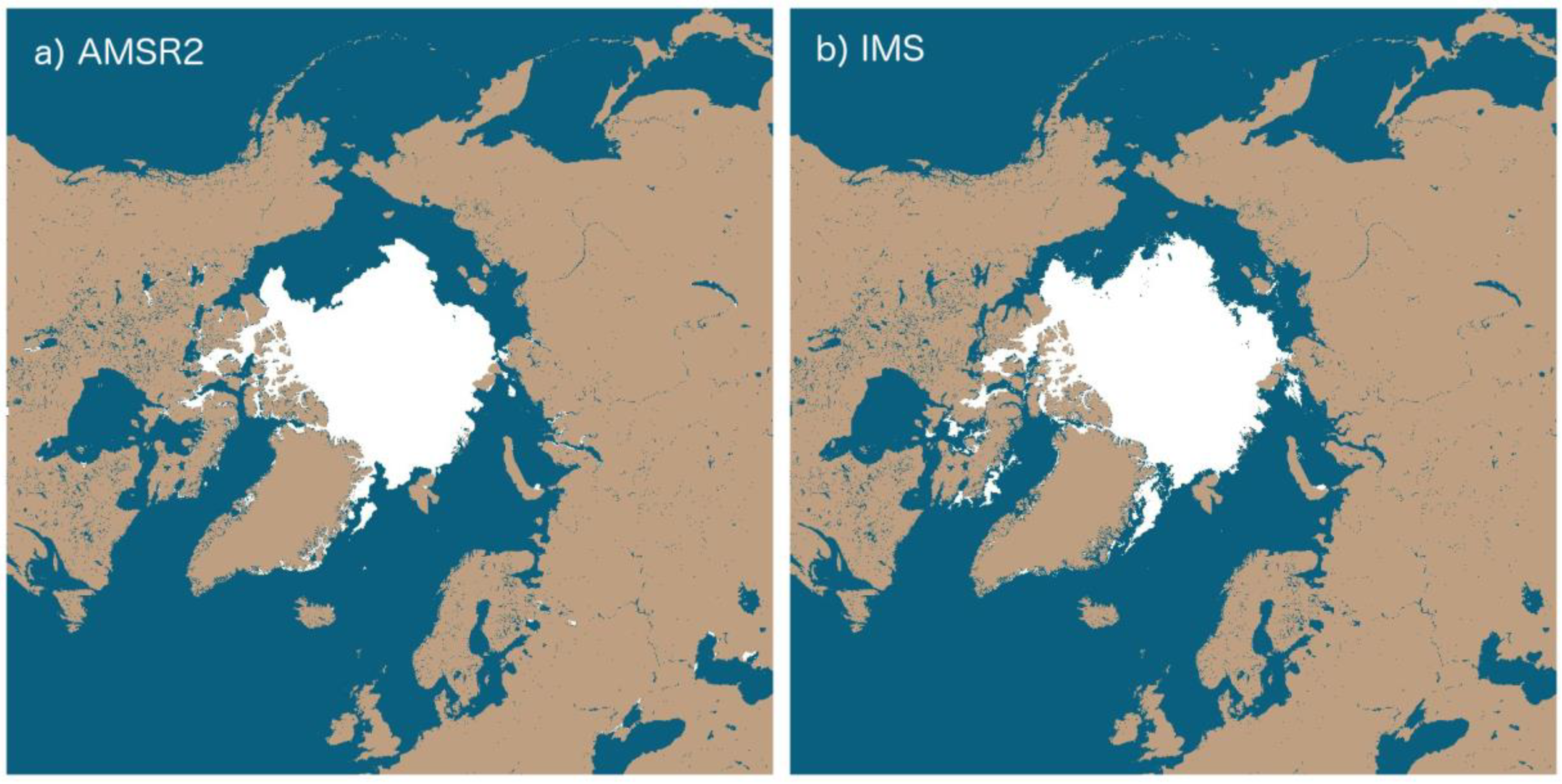
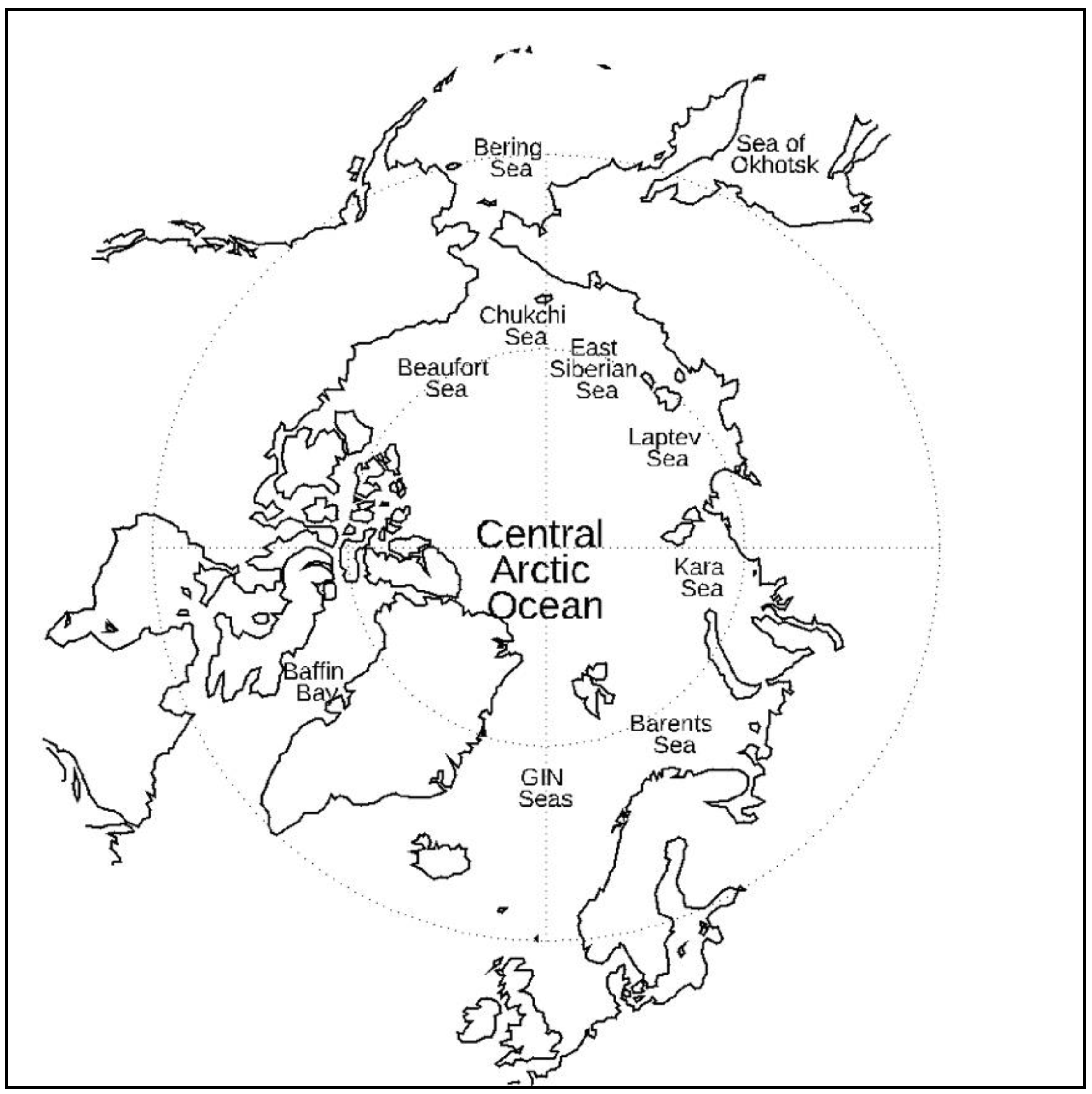
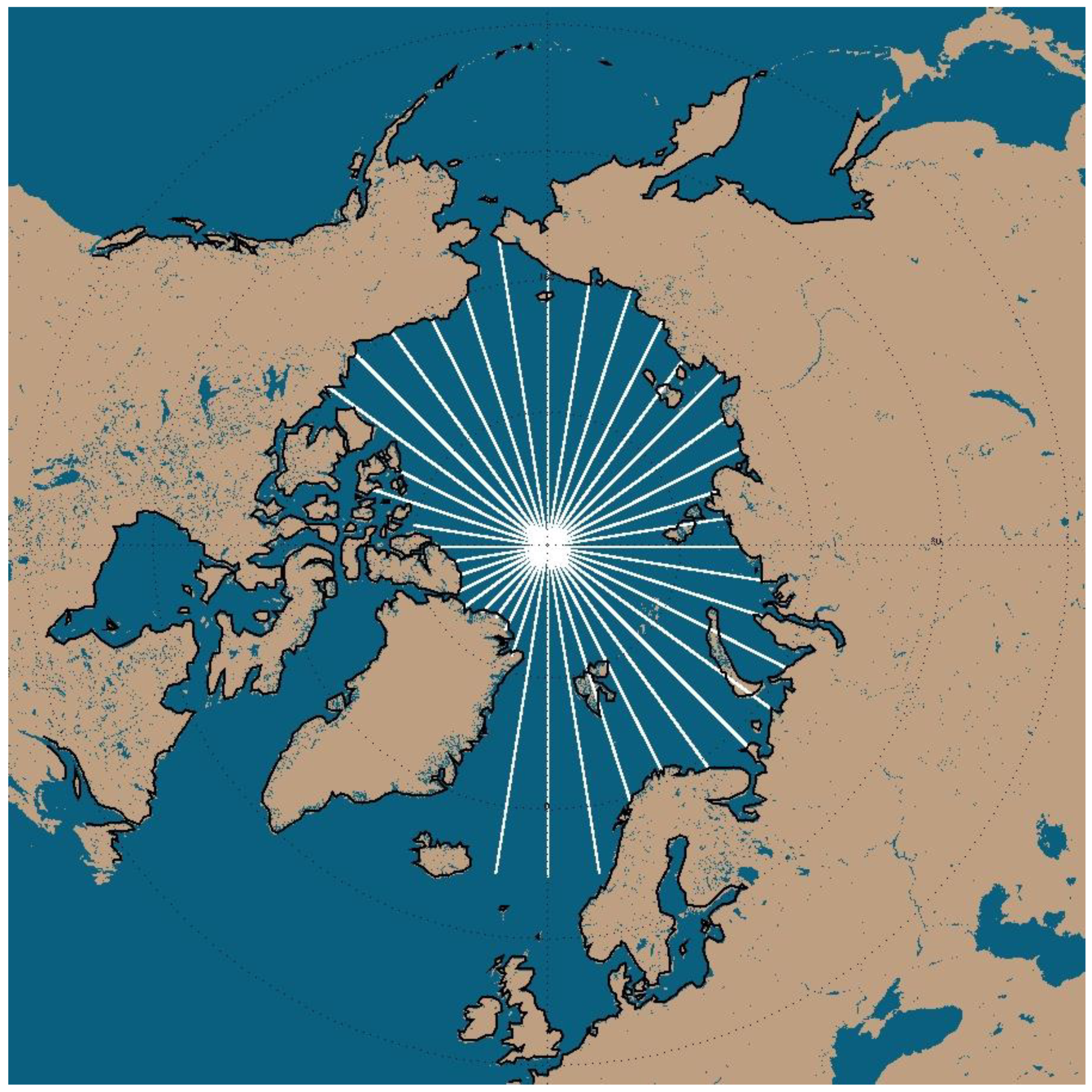

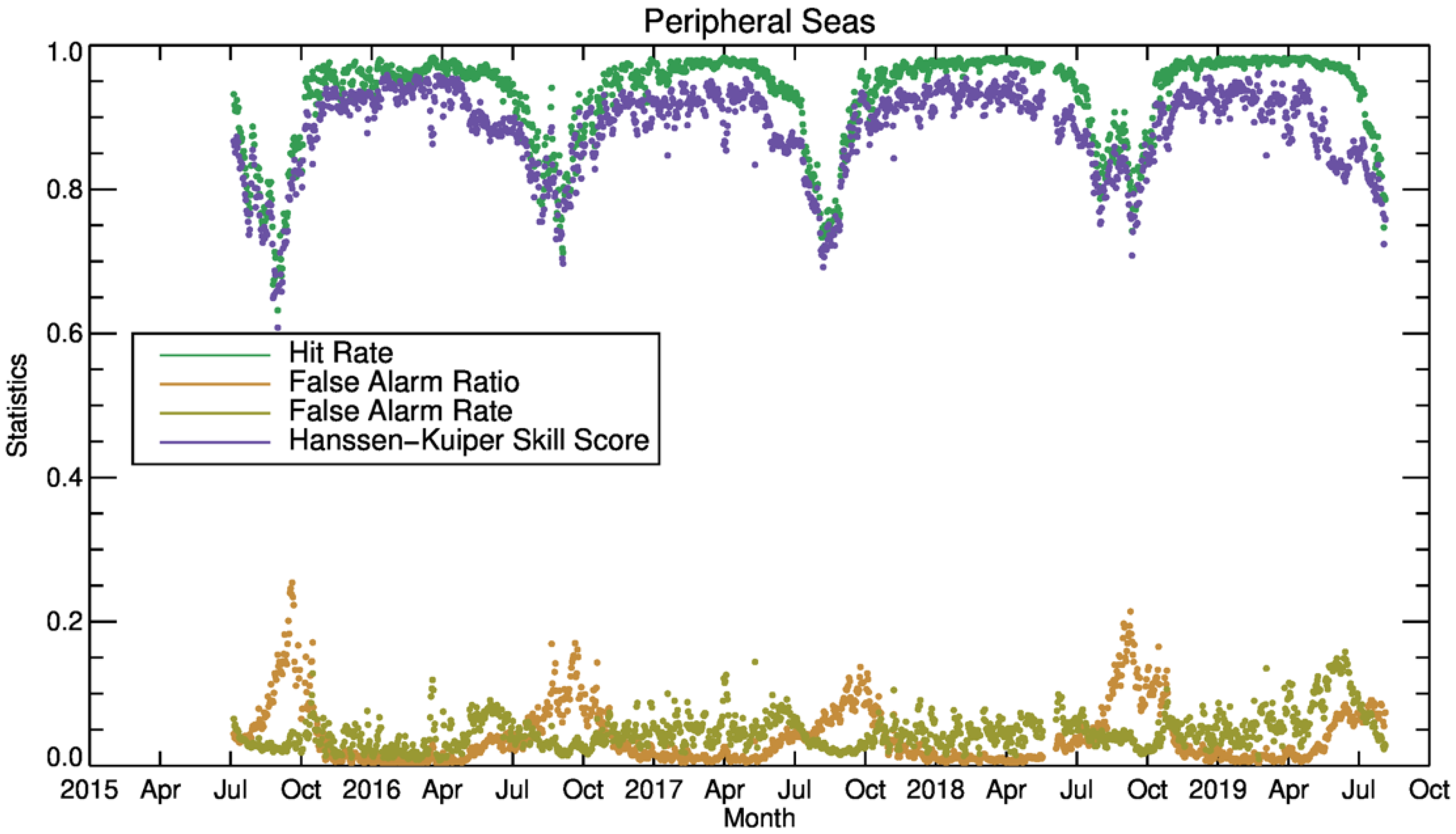
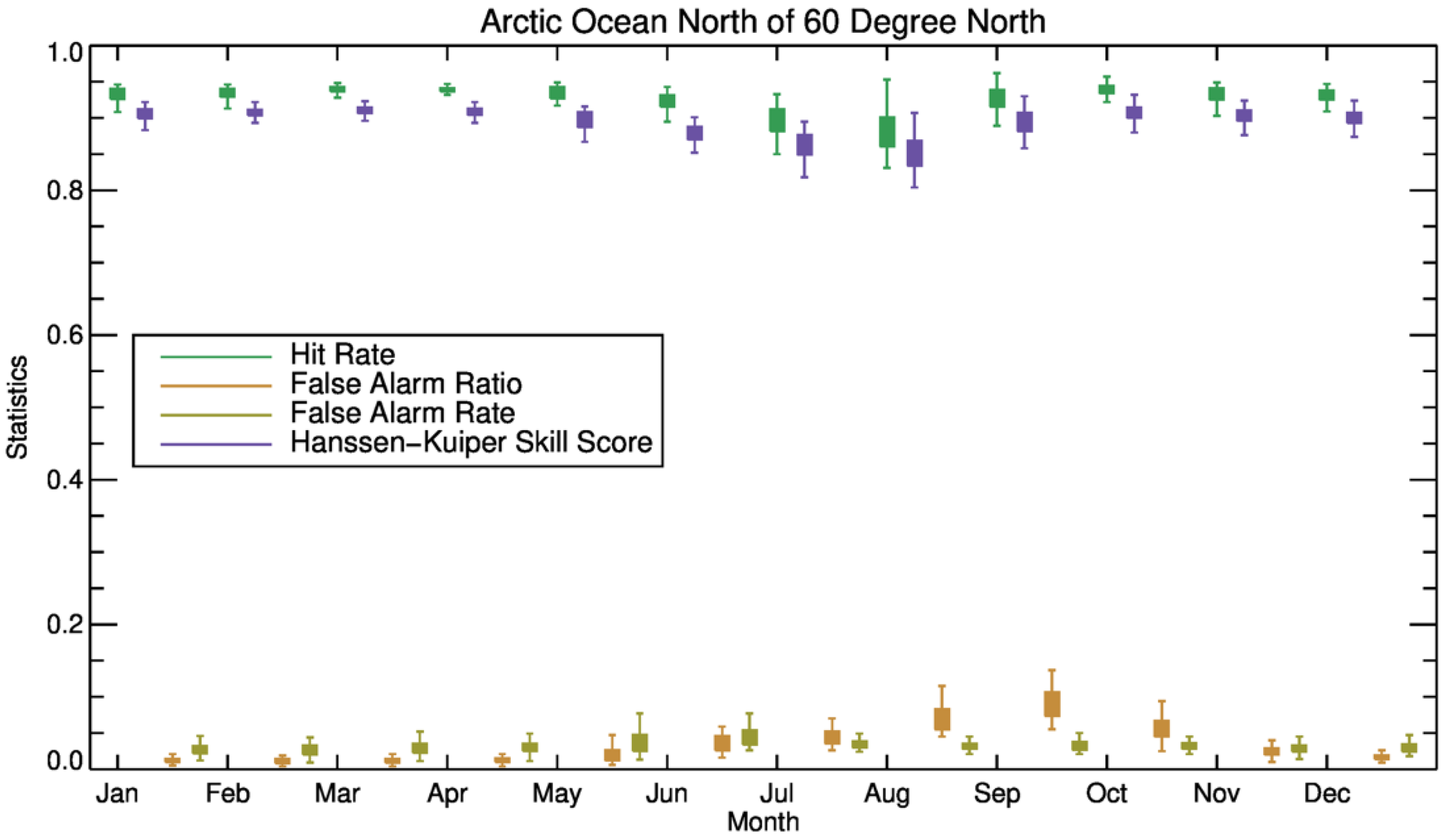
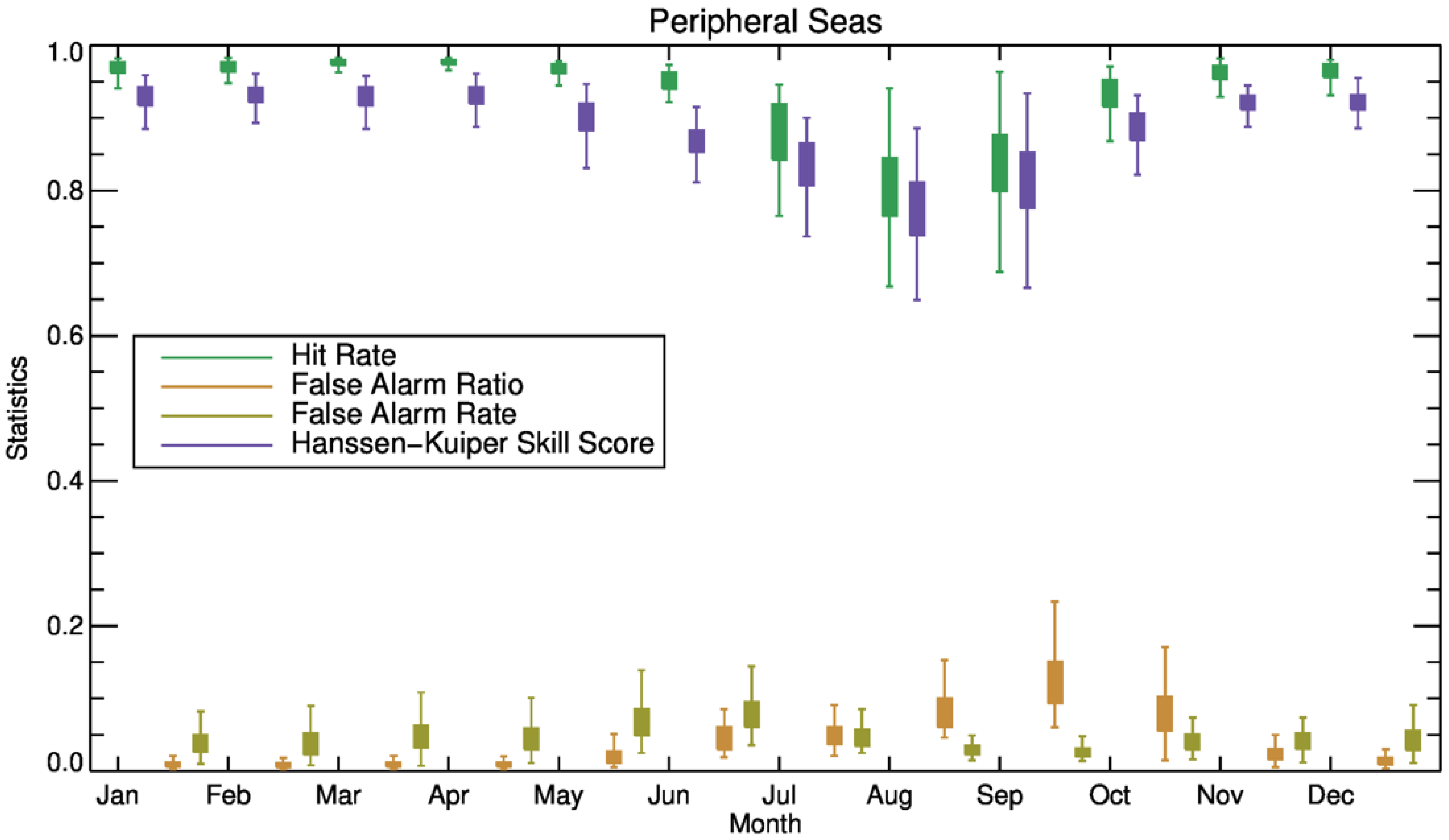
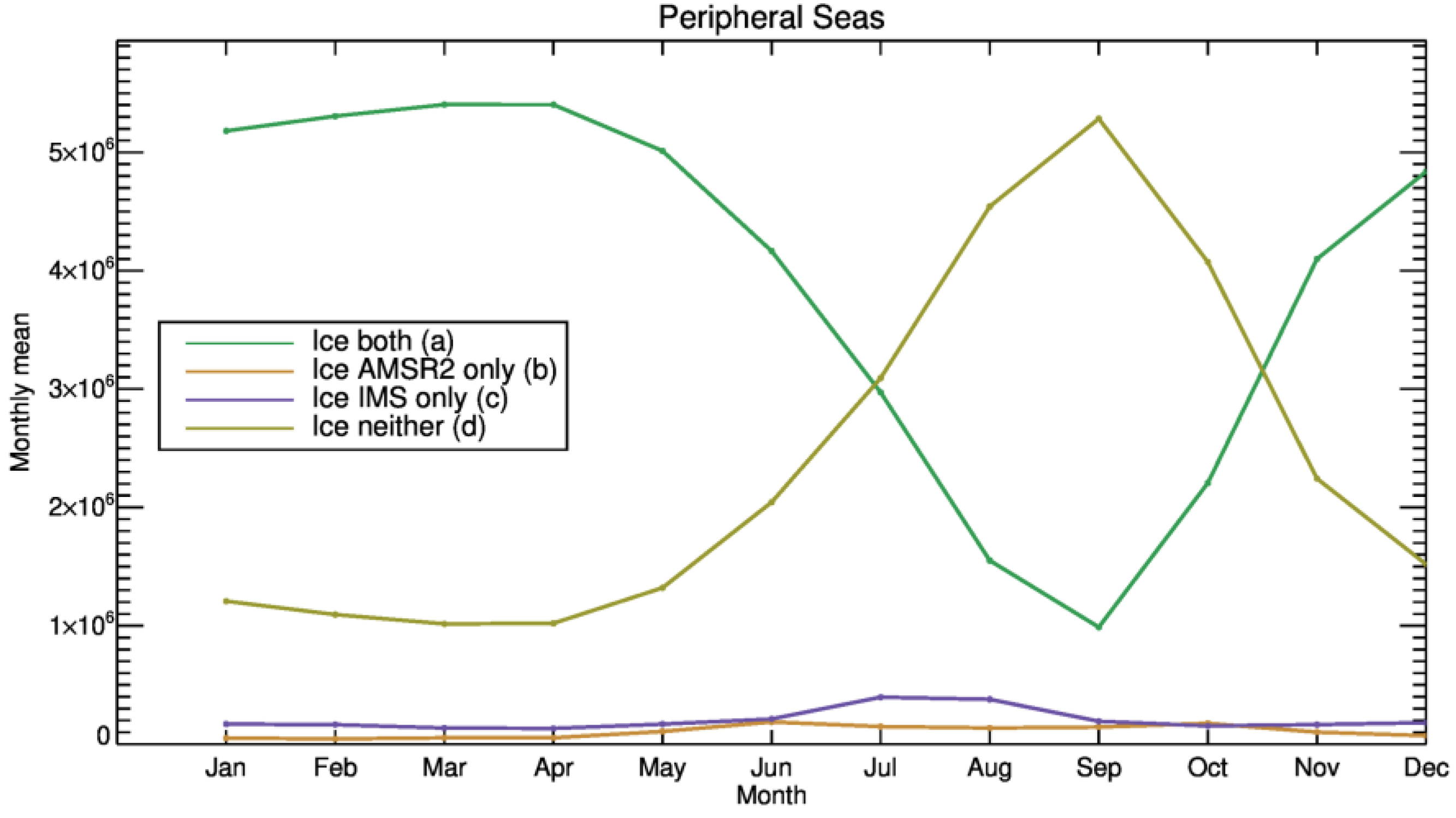
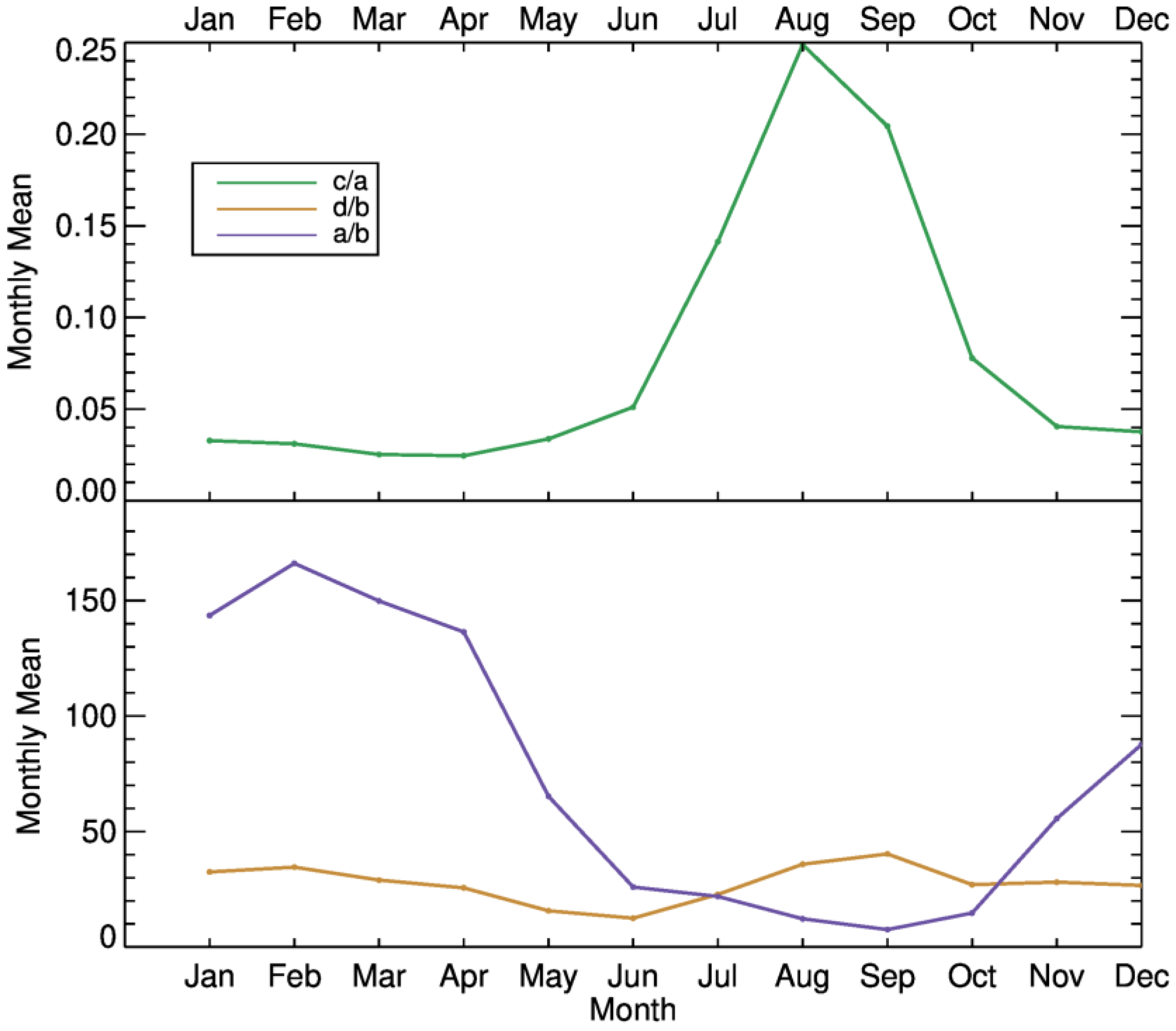
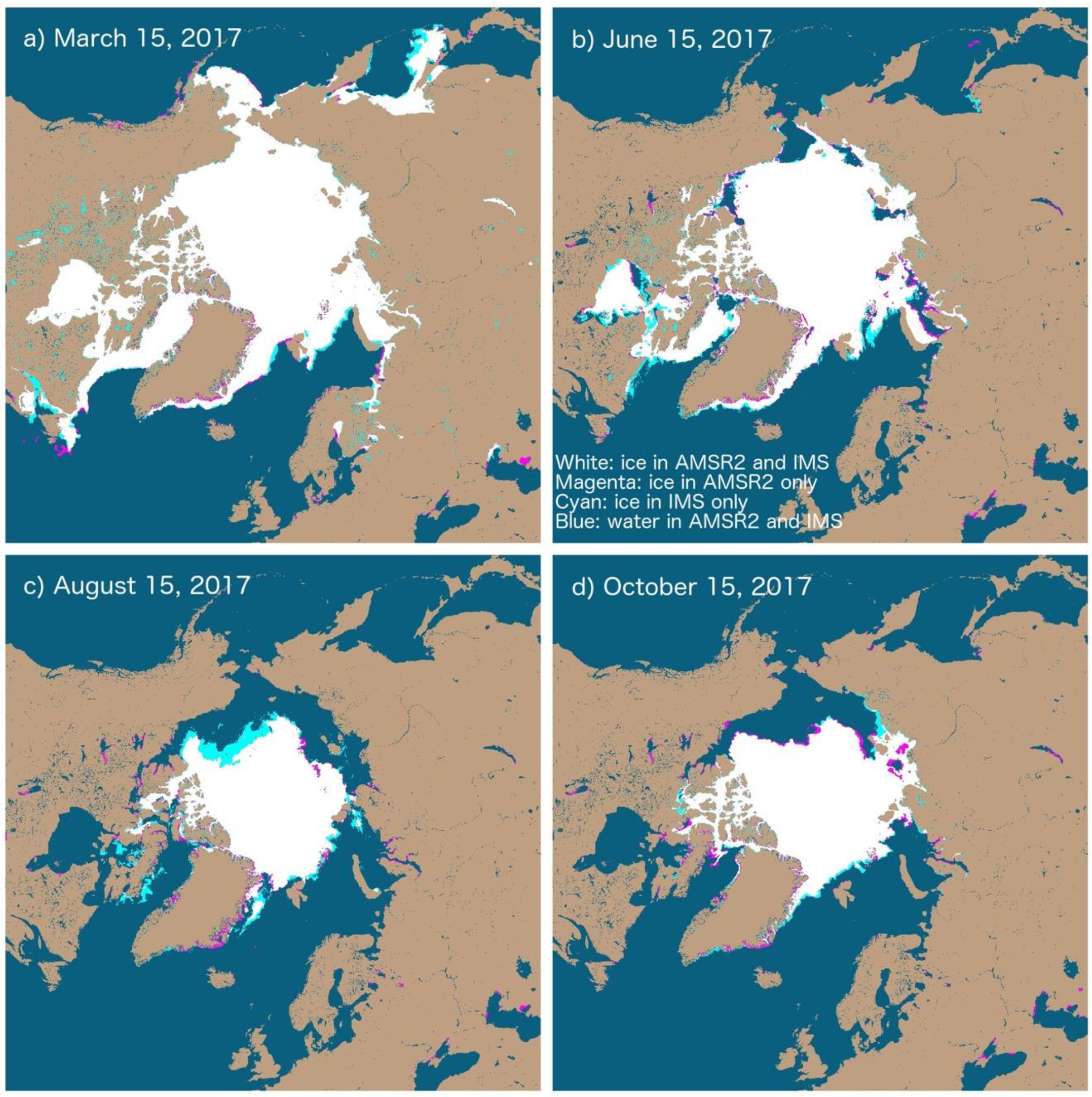
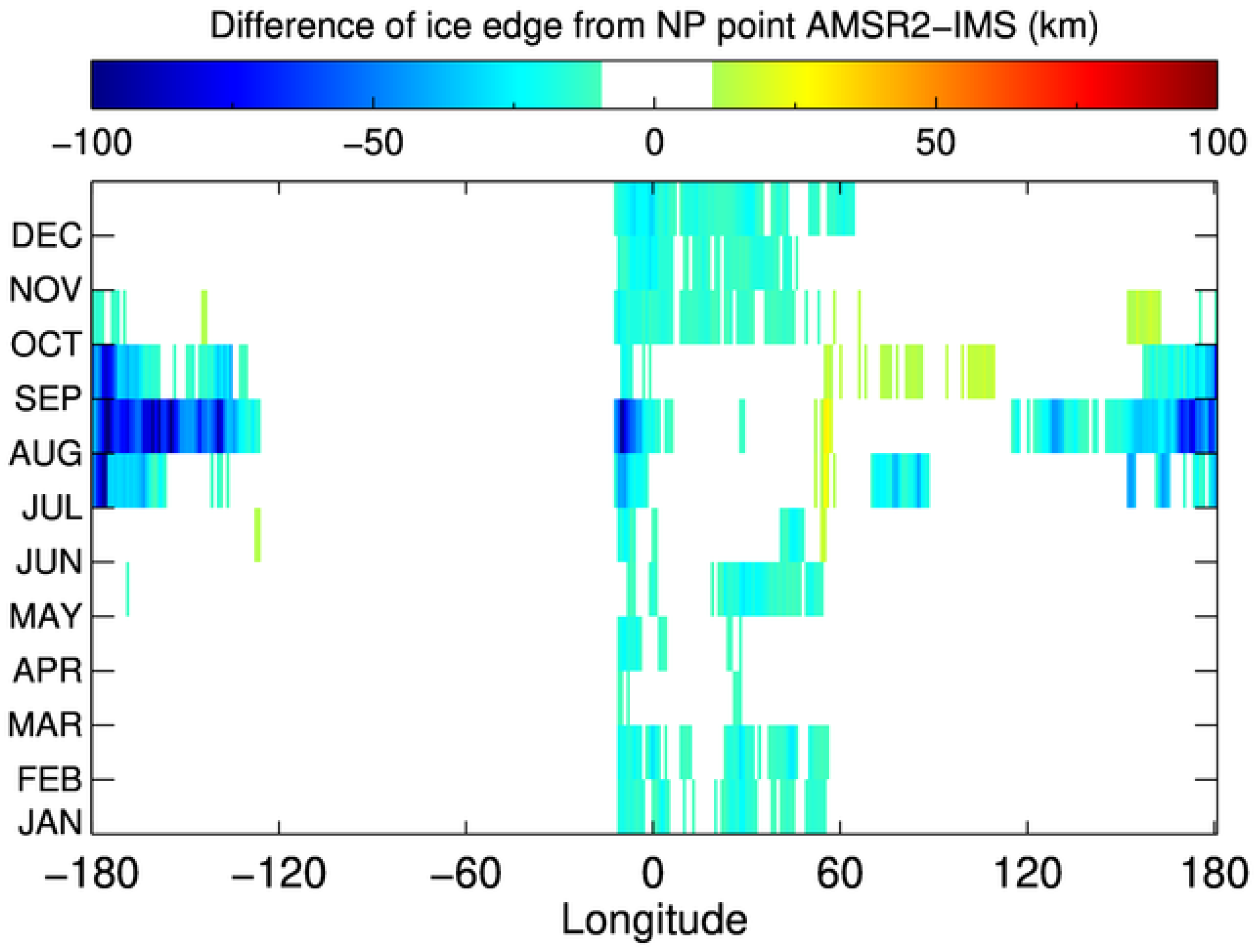
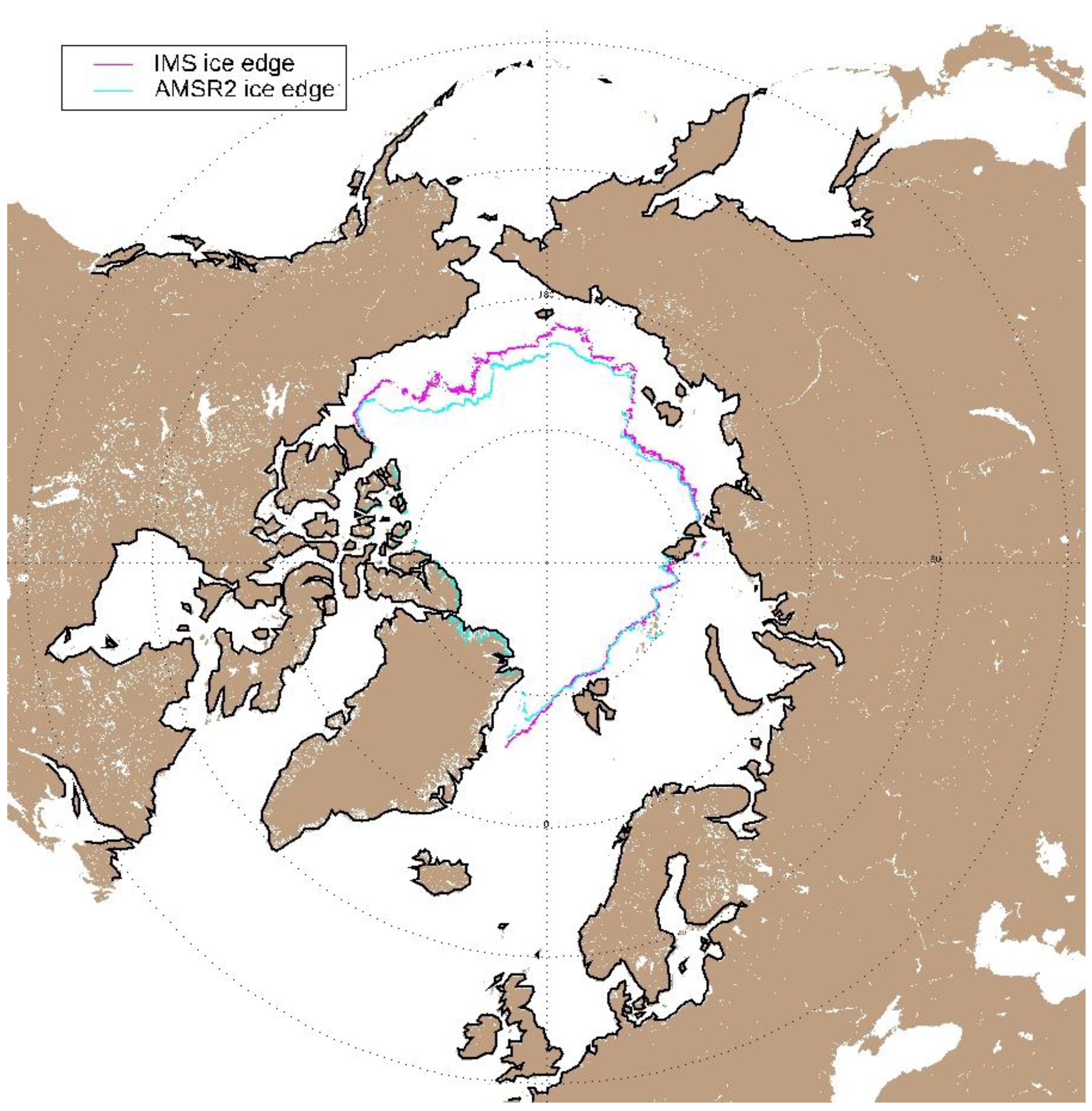
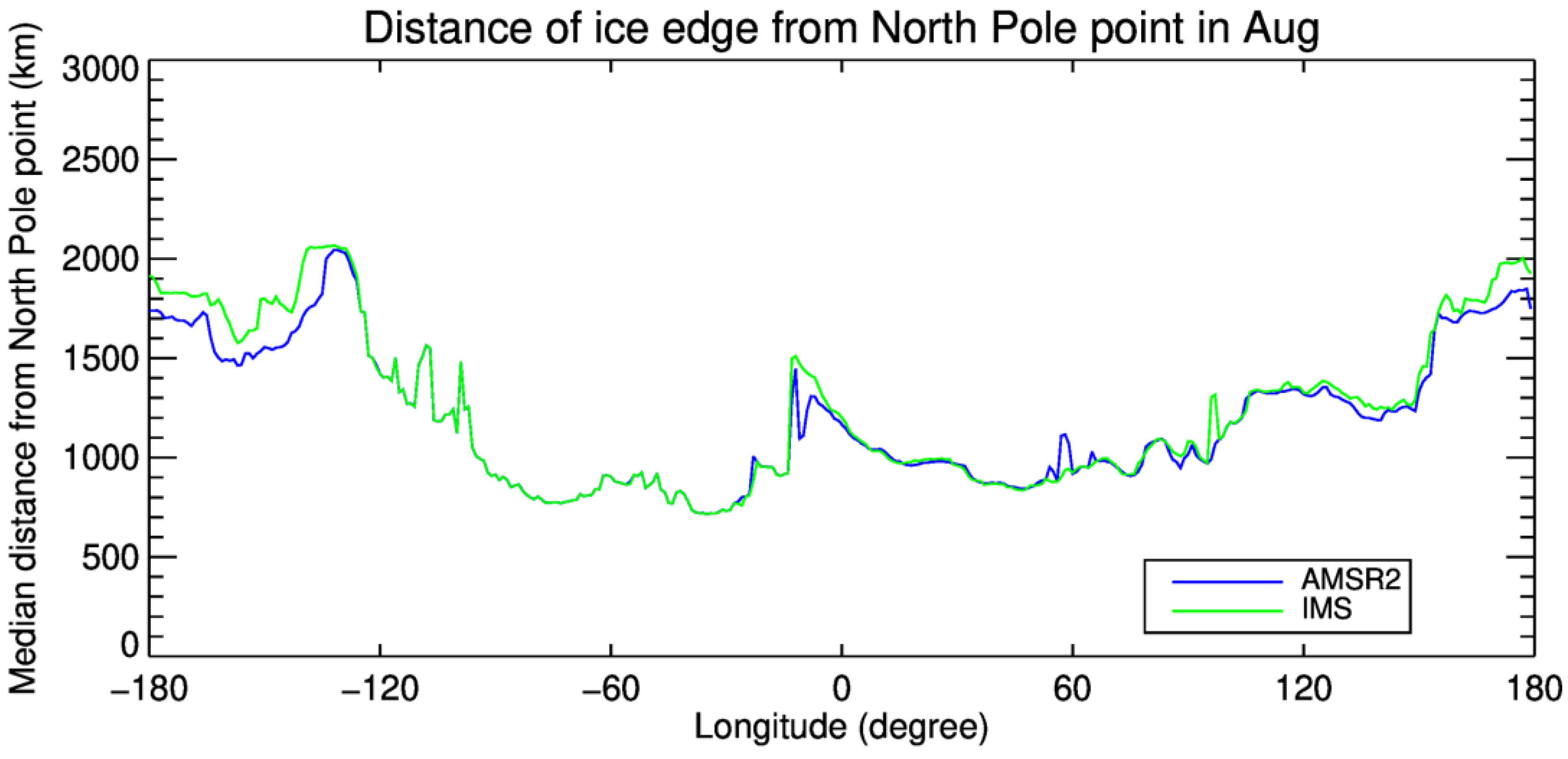
| 2 × 2 Contingency Table | IMS Ice | IMS Water |
|---|---|---|
| AMSR2 ice | a (hits) | b (false alarms) |
| AMSR2 water. | c (misses) | d (correct negatives) |
| Monthly Median | Month | Hit Rate | False Alarm Ratio | False Alarm Rate | Hanssen-Kuiper Skill Score |
|---|---|---|---|---|---|
| Arctic Ocean North of 60° North | Jan | 0.93 | 0.01 | 0.03 | 0.91 |
| Feb | 0.94 | 0.01 | 0.03 | 0.91 | |
| Mar | 0.94 | 0.01 | 0.03 | 0.91 | |
| April | 0.94 | 0.01 | 0.03 | 0.91 | |
| May | 0.93 | 0.02 | 0.03 | 0.90 | |
| June | 0.92 | 0.03 | 0.04 | 0.88 | |
| July | 0.90 | 0.04 | 0.03 | 0.86 | |
| Aug | 0.88 | 0.06 | 0.03 | 0.85 | |
| Spet | 0.93 | 0.09 | 0.03 | 0.90 | |
| Oct | 0.94 | 0.06 | 0.03 | 0.91 | |
| Nov | 0.93 | 0.03 | 0.03 | 0.90 | |
| Dec | 0.93 | 0.02 | 0.03 | 0.90 | |
| Peripheral Seas | Jan | 0.97 | 0.01 | 0.04 | 0.93 |
| Feb | 0.97 | 0.01 | 0.04 | 0.93 | |
| Mar | 0.98 | 0.01 | 0.05 | 0.93 | |
| April | 0.98 | 0.01 | 0.04 | 0.93 | |
| May | 0.97 | 0.02 | 0.06 | 0.90 | |
| June | 0.95 | 0.04 | 0.08 | 0.87 | |
| July | 0.89 | 0.04 | 0.04 | 0.83 | |
| Aug | 0.81 | 0.08 | 0.03 | 0.78 | |
| Spet | 0.85 | 0.12 | 0.02 | 0.81 | |
| Oct | 0.94 | 0.08 | 0.04 | 0.89 | |
| Nov | 0.96 | 0.02 | 0.04 | 0.92 | |
| Dec | 0.97 | 0.01 | 0.04 | 0.92 |
© 2020 by the authors. Licensee MDPI, Basel, Switzerland. This article is an open access article distributed under the terms and conditions of the Creative Commons Attribution (CC BY) license (http://creativecommons.org/licenses/by/4.0/).
Share and Cite
Liu, Y.; Helfrich, S.; Meier, W.N.; Dworak, R. Assessment of AMSR2 Ice Extent and Ice Edge in the Arctic Using IMS. Remote Sens. 2020, 12, 1582. https://doi.org/10.3390/rs12101582
Liu Y, Helfrich S, Meier WN, Dworak R. Assessment of AMSR2 Ice Extent and Ice Edge in the Arctic Using IMS. Remote Sensing. 2020; 12(10):1582. https://doi.org/10.3390/rs12101582
Chicago/Turabian StyleLiu, Yinghui, Sean Helfrich, Walter N. Meier, and Richard Dworak. 2020. "Assessment of AMSR2 Ice Extent and Ice Edge in the Arctic Using IMS" Remote Sensing 12, no. 10: 1582. https://doi.org/10.3390/rs12101582
APA StyleLiu, Y., Helfrich, S., Meier, W. N., & Dworak, R. (2020). Assessment of AMSR2 Ice Extent and Ice Edge in the Arctic Using IMS. Remote Sensing, 12(10), 1582. https://doi.org/10.3390/rs12101582







